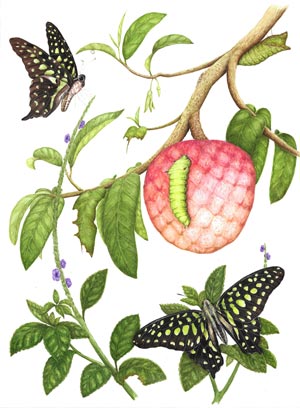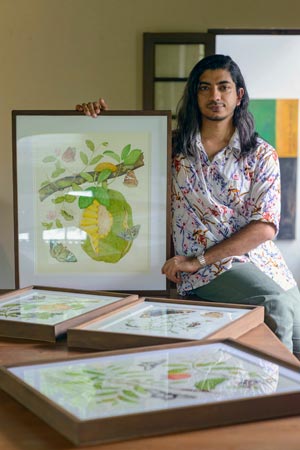True to nature and his art
The painting in a studio away from the main house is large and only half finished. Sanath Herath has just a few days left to get it done, framed, and up at the Barefoot Gallery in time for his first exhibition which opens on September 21.
The artist though is not fazed. He likes challenges and the more intricate and complex, the more he is absorbed. This work needs patience and precision, again qualities he has ample reserves of.
 The painting once completed, will have all the endemic butterflies of Sri Lanka, 31 in total. Into the mountain range backdrop he is painting the different climatic zones in the country from the lowlands to the highlands with the butterflies of each region presented against the vegetation – look closely and you may spot a palmyrah tree, puswel and maybe a rhododendron somewhere.
The painting once completed, will have all the endemic butterflies of Sri Lanka, 31 in total. Into the mountain range backdrop he is painting the different climatic zones in the country from the lowlands to the highlands with the butterflies of each region presented against the vegetation – look closely and you may spot a palmyrah tree, puswel and maybe a rhododendron somewhere.
On the wall beside it is pinned his initial rough sketch and on the other side, a detailed drawing of the butterflies. “When I paint, I need a reference,” he says alluding to the minute details that he has to get absolutely right.
‘Metamorphosis papiliones ceylonesis’ – Metamorphosis of the Butterflies of Ceylon, is this young landscape architect’s first exhibition. Hard to believe that he began painting in earnest just three years ago when fresh from the Moratuwa University he found himself confined by the escalating pandemic, with time on his hands to explore latent interests.
 But then the terrain from which to venture out had long been in place. Growing up in a pastoral village between Gampola and Kandy, Sanath’s childhood was one attuned to nature where though he roamed as he pleased through forests, streams and hills, his parents’ sensitivity to plants and animals was quietly being ingrained in him. They would never tell him not to wield the big stick at plants as boys are wont to do but would rather gently remind him that the plants would hurt if he did so or that a mother bird would be bereft at the loss of an egg, snatched heedlessly from a nest.
But then the terrain from which to venture out had long been in place. Growing up in a pastoral village between Gampola and Kandy, Sanath’s childhood was one attuned to nature where though he roamed as he pleased through forests, streams and hills, his parents’ sensitivity to plants and animals was quietly being ingrained in him. They would never tell him not to wield the big stick at plants as boys are wont to do but would rather gently remind him that the plants would hurt if he did so or that a mother bird would be bereft at the loss of an egg, snatched heedlessly from a nest.
He started out at the village school in Weligalla, and went on to Dharmaraja College, Kandy and then to the Moratuwa University to major in Landscape Architecture. And it is here that he now lectures to students following the same course of study as he did a few years ago.
Interestingly in his schooldays, it was Eastern music not art that he pursued (he plays the violin and tabla) and a musician friend of his father’s took him to the next level, discovering the depth and range of the music. Now into Western classical music, he is learning to play the piano and enjoying Chopin while he works long into the night when all is still, with only his cat Mittens keeping him company.
Landscape architecture seemed a natural choice of study given his love for nature and he found the nexus between how the built environment can affect ecological aspects and vice versa fascinating. Having moved from the green spaces of the village to the stuffy confines of the capital, he has felt the difference, and talks passionately about the endless possibilities to incorporate features like rainwater harvesting, green spaces within urban environments and how there needs to be more awareness of such interventions that can minimize the negative impacts on the environment taking place around us.
It was when he started painting seriously that he began studying the work of natural history artists, among them the 17th century German artist Maria Sibylla Merian, Martin Johnson Heade, Elizabeth Blackwell and Ferdinand Bauer and the interpretation of nature in different cultures. He was struck, for instance, by how Merian changed the idea of scientific diagram into scientific art – the composition, the proportion, the colours slightly. He himself focuses on how he perceives these particular species in nature. “I try to keep it scientifically accurate while changing it artistically,” he says, aware that he is indeed treading a very fine line between the two.
Chancing upon G.M. Henry ‘Birds of Ceylon’, he was intrigued by the intricacy of the drawings. Reinterpreting these bird pictures, he says, involved in a certain degree of colour correction, different composition – the particular behaviour of the subject, he says, citing the junglefowl’s ‘weird’ walk, while adding a touch of background detail in the plants or habitat the bird favours.

Sanath Herath: Portrait of the artist by Dominic Sansoni
The idea of metamorphosis is what prompted this forthcoming butterfly exhibition at the Barefoot Gallery where he will show 25-30 paintings in three different sizes. The transformation of a butterfly is symbolic of life’s journey itself he says and in many cultures butterflies are considered auspicious. The subject also relates to his desire to focus attention on the need for ecological preservation – all the butterflies he has drawn for this exhibition are either endemic or endemic sub-species he says, many also on the IUCN Red List. While he has travelled the island to see these butterflies in their natural habitat, some key volumes have been constant reference points– “The Butterfly Fauna of Sri Lanka’ by George Michael van der Poorten, a 1953 edition of ‘Wildflowers from the Ceylon Hills’ by Thomas E.T. Bond and Dorothy Fernando’s ‘Wildflowers of Ceylon’.
“I think for the first time you can see the full life cycle of the butterfly with their larva food plants and the adult food plant in a single painting. Lots of research went into it.” His hope is that people will notice not just the butterflies but the plants he has drawn too and be prompted to grow them in their gardens, quite easily done, he says, his landscape architect’s expertise very much in evidence.
Early days in his career these may be (he’s 30), but his work has been quickly spotted by private collectors and interesting commissions for hotels have followed. A recent satisfying project was the ecologically themed ‘Denrobium House’ in the Hantane hills designed by leading architect Channa Daswatte, for which Sanath did a series of paintings on raptors, butterflies, moths, vines and the like, focusing on his native and endemic species.
As to whether his path ahead lies in art, landscape architecture or academia, he looks to personalities like Sri Lanka’s very own Laki Senanayake and the Brazilian landscape designer Roberto Burle Marx who defying stereotypical labels, effortlessly embraced and explored different disciplines weaving them harmoniously into works that broke new ground.
A defining characteristic was that they were always discovering new paths to pursue. Sanath himself delights in exploring new mediums and genres – he has gone into abstract art, concept art and even illuminated manuscripts – the latter more associated with medieval times when books were handwritten and the accompanying illustrations painted in gold, silver and similar rich shimmering hues. His work in this field – done in his own style – was picked up by a perfume company in India and some of his bird illustrations featured in Coonoor and Co, an online Indian magazine. So an endless space for exploration and experimentation beckons.
Totally absorbed and in a meditative state when he paints, he says that if one is inspired by nature, a lifetime isn’t enough. His butterfly exhibition then is just that early window into more fields of exploration.
Sanath Herath’s exhibition ‘Metamorphosis Papiliones ceylonesis’ – Metamorphosis of the Butterflies of Ceylon is on at the Barefoot Gallery from September 22 to October 15 from 10 a.m. to 6.p.m.
Searching for an ideal partner? Find your soul mate on Hitad.lk, Sri Lanka's favourite marriage proposals page. With Hitad.lk matrimonial advertisements you have access to thousands of ads from potential suitors who are looking for someone just like you.


